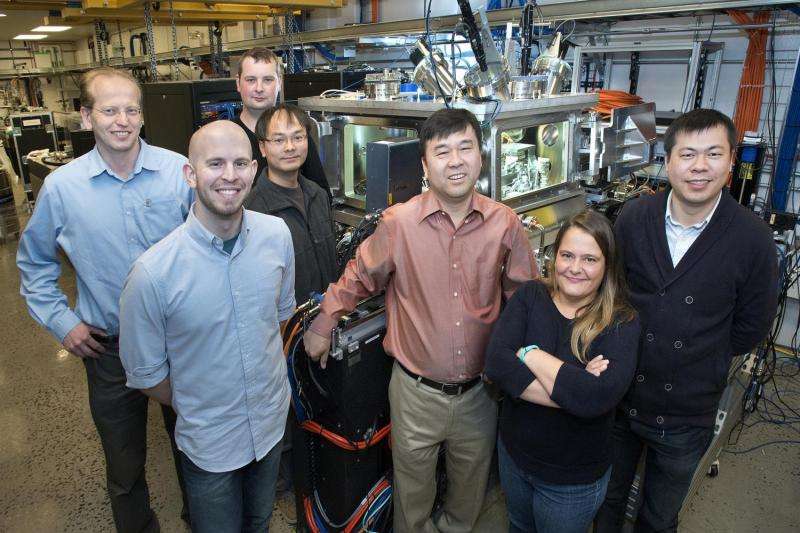New lenses grown layer-by-layer increase X-ray power

When you're working with the brightest x-ray light source in the world, it's crucial that you make use of as many of the photons produced as possible. That's why physicists Hanfei Yan and Nathalie Bouet at the National Synchrotron Light Source II (NSLS-II) are developing new lenses that focus x-ray beams to smaller spot sizes made up of more photons for better imaging resolution. NSLS-II is the newest facility at the U.S. Department of Energy's Brookhaven National Laboratory, and it's already pushing the boundaries of imaging capabilities at synchrotrons. With the work on wedged multilayer Laue lenses, published on May 4th in Optics Express, Hanfei and his collaborators are pushing those boundaries even further.
"We have two goals – we want to increase the x-ray image resolution and at the same time, we want to make use of more of the photons produced by our accelerator," Yan said.
Multilayer Laue lenses (MLLs) are an alternative to the more commonly used zone plates, and scientists predict that MLLs will provide better spatial resolution and more efficiently focus the hard x-ray beams provided by NSLS-II. Because of these improvements, fabrication of high-quality MLLs has been in development for years at NSLS-II. Flat lenses have been developed and tested, with good results.
"We have succeeded in focusing X-rays down to 11 nanometers using flat multilayer Laue lenses. That's just ten thousandth the width of a human hair," said Xiaojing Huang, the lead author of this publication. "Our next goal is to capture more of the photons from the X-ray beam into the focus spot, fully taking advantage of the brightness NSLS-II offers."
With flat lenses, only a portion of the lens is optimized for a particular focusing condition. To ensure that all portions of the lens achieve maximum focusing simultaneously, the lenses must be tilted progressively to make an angle through which the X-rays pass. That means making MLLs with a wedged shape to the lens.
"That's our motivation for building the wedged MLLs. We want to push the focusing efficiency higher and maximize the amount of photons we use," Huang said.
"But, there is no free lunch", said Nathalie Bouet, who is leading the BNL's efforts for fabricating MLLs. "Fabricating the wedged MLLs requires precise three dimensional control for multilayer deposition, far more challenging than making the flat MLLs."
Wedges are in this season
Whether wedged or flat, multilayer Laue lenses are made of thousands of layers, grown one layer at a time. In this work, Bouet and her collaborators used sputtering deposition, in which ions generated in plasma are blasted at a target material. That material's atoms then condense on a silicon base to form a film.
For these multilayer lenses, two materials with different optical properties are used: silicon and tungsten silicide. By moving the base layer back and forth in front of these two targets, many layers are deposited. With flat MLLs, the key is controlling the uniformity of the layers, but for wedged MLLs, it's even more difficult. Each individual layer must form a slightly different angle than the one before it in order to result in a perfect wedge that will diffract x-rays efficiently and maximize the amount of photons that are focused on a sample material.
The team of researchers from Brookhaven, in close collaboration with scientists from the Advanced Photon Source at Argonne National Laboratory, found that their wedged multilayer Laue lenses make use of 27 percent of the x-ray beam. That doubles the amount from a flat MLL, though theoretically, they should be able to push the efficiency up to 50 percent. Therefore, there is still a lot of room for improvement.
This significant increase of efficiency is a result of selecting a wedge from the flat "layer cake" with precisely the correct angle. These are extremely difficult to fabricate, but the results of their tests on these prototypes show that it's certainly worth it. Using the Advanced Photon Source at Argonne National Laboratory, they used x-rays to characterize the shape and performance of the wedges. Their findings indicate that use of these lenses will potentially result in a smaller x-ray spot size on samples, leading to higher resolution images that can be taken in a smaller amount of time.
The wedged multilayer Laue lenses will be used at the Hard X-Ray Nanoprobe beamline at NSLS-II, where a MLL x-ray microscope module is being commissioned now. In addition to increasing the focusing efficiency, the wedged MLLs are critical to achieving a focus size below 10 nanometers.
"These wedged lenses will increase the measurement speed by four times," said Yong Chu, the lead scientist for the HXN beamline. "When fully optimized, we expect to gain a twenty-fold enhancement in imaging throughput."
Optimizing the wedged MLL fabrication for a 5 nanometer focus size is the next grand challenge for the NSLS-II.
Journal information: Optics Express
Provided by Brookhaven National Laboratory




















